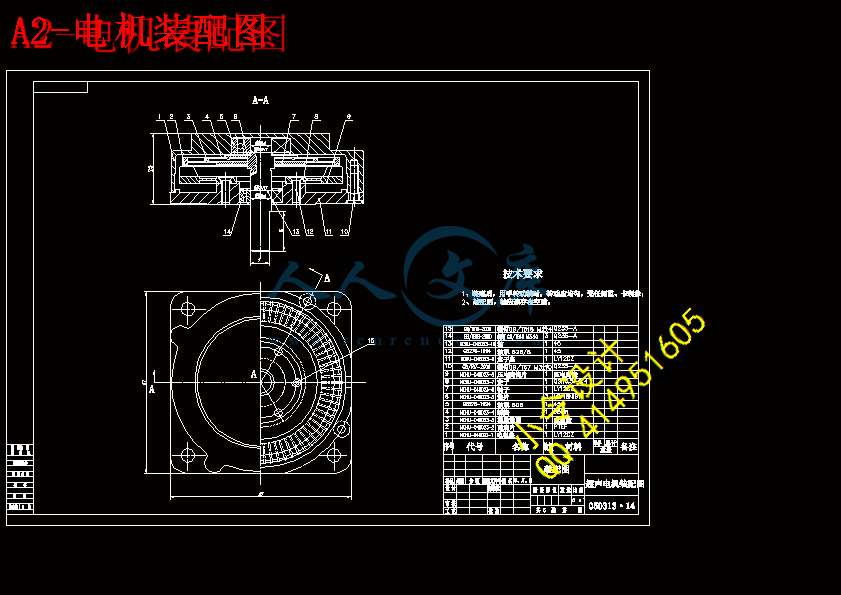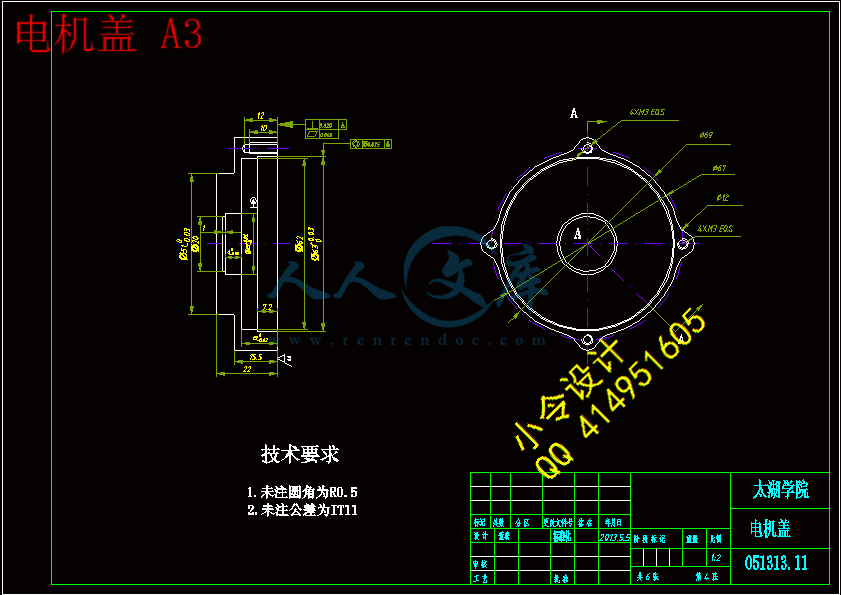摘要
超声电机是利用压电陶瓷的逆压电效应,激励弹性体产生谐振作用,把电能转换成微米级振幅的振动,再依靠定子和转子之间产生的摩擦耦合将这细微振动扩大为转子及与之相联的轴的旋转运动。与传统电磁电机相比,具有质量小、结构简单、高效率、低噪音、低速大转矩和可以直接驱动负载等特点。在航空航天、精密仪器、生物医学与许多重要领域等具有广阔的应用前景。
适应于工程上对超声电机的需要,本文设计了一种旋转型行波超声电机,主要完成了以下工作:
1.总结分析了国内超声电机技术的现状、发展及所存在的问题;
2.阐释了旋转行波超声电机的运动机理;
3.利用ANSYS软件建立了超声电机定子的数学模型,利用模型对定子的工作模态进行分析并计算,确定超声电机的定子的工作模态;
4.完成了直径超声电机的装配图和零件图的设计;
关键词:超声电机;模态分析;设计
Abstract
Ultrasonic Motor uses the effect of Piezoelectric from Piezoelectric ceramic, and it produce the effect of resonance excitation by the Active Materials. That the electrical energy transform to the micro-deformations. To propel the rotor and the drive shaft connected to it though the amplification of the micro-deformation of the active material that depends on friction at the interface between rotor and stator.The Ultrasonic Motor offer light mass, simply constructions, high torque density at low speed, low noise, efficient and actuate directly to the load. Ultrasonic motor in the aviation and aerospace, precision instruments, bio-medicine and a number of important areas has broad application prospects.
Projects adapted to the needs of the ultrasonic motor, In this paper, the design a rotary traveling wave type ultrasonic motor, the main completed the following work:
1.Summary analysis of the domestic status of ultrasonic motor technology, development and the problems;
2.To explain the rotary traveling wave ultrasonic motor of the movement mechanism;
3.The use of ANSYS software, the establishment of a ultrasonic motor mathematical model, using the model of the work of the stator modal analysis and calculation to determine a stator ultrasonic motor mode of work;
4.Completed a ultrasonic motor assembly drawings and parts of the design plan;
Key word: Ultrasonic Motor ; Modal Analysis; Design
目录
摘 要III
AbstractIV
目录VII
1 绪论1
1.1 超声电机的定义1
1.2 超声电机的特点1
1.3 超声电机的发展历史2
1.4 超声电机的应用及发展前景4
1.5 本次课题的研究方向及安排4
2 旋转行波超声电机的工作原理5
2.1 引言5
2.2 旋转行波超声电机的机械结构5
2.3 超声电机的工作原理5
2.4 压电陶瓷的工作原理6
2.5 定子行波的产生7
2.6 定子表面质点运动分析8
2.7 本章小结10
3 定子模态分析计算11
3.1 导言11
3.2 固有频率的理论计算11
3.2.1 共振频率计算11
3.2.2 共振振幅的计算13
3.3 定子建模分析14
3.3.1 ANSYS软件简介14
3.3.2 ANSYS定子建模15
3.3.3 定子分析18
3.4 本章小结20
4 结构设计21
4.1 导言21
4.2 设计流程21
4.3 定子机构设计22
4.3.1 定子内外径设计23
4.3.2 模态阶数选择和振动模态设计23
4.3.3 定子厚度24
4.3.4 驱动齿设计24
4.3.5 内支撑板设计24
4.4 转子设计24
4.5摩擦层设计26
4.6 设计结果26
4.7 电机设计结果装配结构27
4.8 本章小结29
5 结论与展望30
5.1 全文主要内容30
5.2 工作展望30
5.3 心得体会30
致 谢31
参考文献32
1 绪论
1.1 超声电机的定义
超声电机又叫做超声马达。超声电机利用压电材料的逆压电效应。实现电能对机械能的转化。相对于传统电机不同,超声电机是利用超声波频率范围内的机械震动作为驱动源的驱动器。超声电机的英文名为Ultrasonic motor。简称为USM。
1.2 超声电机的特点
超声电机是一种新型的电机,它与传统意义上的电机无论是在使用上还是原理上都有很大的不同。超声电机具有以下几个特点
1)超声电机的能量转换方式不同于传统电机。传统的电机,如异步电机等是通过电场的相互作用酱电能转换成机械能,电机的定子和转子并不直接接触,定转子间是有间隙的。通过电源供电产生电能,经过定子和转子上的线圈产生磁场,磁场力作用于转子,产生机械能。可以看出传统电机的机械能主要靠电磁感应作用由电能转化而来。而超声电机不同于传统电机,超声电机的定子和转子是靠摩擦耦合将动力转换成转子或滑块运动,定子和转子是需要直接接触。因为超声电机不靠电磁感应原理来实现能量转换,所以超声电机不需要刺激和绕组。超声电机利用逆压电效应,在定子上粘贴上压电陶瓷元件,同时对压电陶瓷原件上施加交变电压,使定子产生高频机械振动,振动产生的定子和转子间的摩擦力使转子做定向的回转或直线运动。所以超声电机存在两种能量转换1.压电陶瓷利用逆压电效应实现电能对机械能的转换。2.定转子之间摩擦产生的机械能转换[1]。
2)超声电机具有转速低转矩大的特点。图1.1和图1.2分别为电磁电机和超声电机的转矩/效率-速度曲线图。由图可见,超声电机在小转矩,大转速的情况下效率高。而在低速大转矩的情况下效率则比较低下。
图1.1图1.2
3)超声电机具有体积较小,重量轻。超声电机依靠定子和转子的摩擦耦合获得机械能,不需要线圈和磁铁,因此相较于普通电机超声电机在相同转矩情况下拥有较小的体积和更轻的重量。
4)无电磁干扰和电磁噪声,电磁兼容性好。因为超声电机没有磁极,所以不收外界电磁的影响,自身也没有电磁感应的影响。因此超声电机适合在强磁场的环境下工作。
1)超声电机具有耐低温的特性,适合在真空的环境下运行,如在太空中。超声电机的定转子具有直接物理接触。当断电后,在静摩擦力的作用下仍能保持很大力矩。
2)结构简单,设计形式自由度大,可以根据需要改动电机的设计
虽然超声电机在半个世纪来的发展下已经具有很有传统电机不具有的很多优良的性能,但是一些不足之处仍然存在
3)超声电机使用寿命短
4)成本高昂
在高温环境下或者在长时间工作使超声电机自身温度上升之后,压电陶瓷在高温下物理特性会发生变化,影响电机的参数,导致电机性能的变化。
综上所述,超声电机在有些地方还是有许多不足的地方,但是,不可否认的是超声电机具有它独有的优越性能。而随着科技的发展,超声电机的部分缺点也在慢慢的被克服。因此在本次的设计中,应该做到取长补短,尽可能的把超声电机的优点发挥到最大,同时把超声电机缺点影响降至最小[2-4]。
1.3 超声电机的发展历史
超声电机的制作设计到许多领域的科学成果,包括机械,声学,摩擦,振动,等很多方面的学科及领域。超声电机的出现以及发展取决于很多方面的突破,如压电陶瓷材料的发现及改进。大致来说,超声电机的发展可以分为三个阶段,即超声电机概念阶段、具有实用前景的样机阶段和产业化生产及应用阶段。
1880年,居里夫妇发现压电效应,但是受当时的科学水平所限,对于压电效应的应用仅仅处于一个很狭小的领域,只局限于水声和电声器件。20世纪40年代初,美苏科学家同时发现了BaTiO3陶瓷的铁电性,这对压电陶瓷的发展产生。 重要的意义。1942年,美国学者Williams和W.Brown申请了第一个超声电机的模型专利。如图为第一个超声电机的模型,四片压电陶瓷分为两组粘贴在截面为正方形的长条弹性体的两个侧面上,对其施加两相相位差为90º的交变电压激励,能够在长条弹性体中激励起两个方面和频率相同的弯曲震动,从而在弹性体端部质点做椭圆摇摆运动,此椭圆摇摆运动就可以驱动压在其上的转子或者移动体。此模型类似于如今的杆式超声电机。但是因为当时的技术水平已经材料方面的问题所制约,这个模型最终没能变成一个真正的样机。
图1.3 最早的超声电机设想模型
在此之后,压电陶瓷的技术革新在不断的进行。1942年S.Robert 发现在BaTiO3陶瓷上施加直流偏压,该陶瓷会呈现强的压电效应。1954年贾非等发现PZT有良好的压电节点性能。这些压电材料的丰富和进步,以及科技水平的发展,超声电机的研究在这样的环境下得到了很快的进步和提升。1961年,日本Bulova钟表公司研制出一种新型钟表,该钟表利用音叉的往复位移拨动棘轮而获得驱动。该钟表的精确度相当高,仅有1min的月误差。这种领先于当时科技水平的钟表,造就了超声电机的样机雏形。1963年,苏联科学家设计出了一台利用轴向弯曲耦合振动的振动片型超声电机,并且由此总结解释出了超声电机的工作原理。1972年前后,德国西门子和日本松下两家公司研究出了利用电谐振工作的直线驱动机械,这种机械拥有高达输完赫兹的振频,但是却因为振幅过小,无法发挥较大的实用价值。1987年,前苏联科学家研究出一种能驱动较大负载的超声电机。这种电机是利用振动片的纵向振动和弯曲振动,再通过摩擦耦合,把机械能传递给转子。
1980年,日本科学家指田年生在苏联科学家的研究基础上,成功制造出一种驻波型超声电机。这种电机的工作频率为27.8KHz,电压300V,输入功率90W,输出功率50W,转速2000r/min,机械效率为55%。这是世界上第一台能应用于实际中的超声电机。但是这部电机在使用过程中磨损十分严重,严重影响电机的使用寿命。1982年,指田年生发明了行波型超声电机,该电机此电机实现了断续点接触变换成多点连续不间断接触推动转子运动,大大的降低了电机的磨损,延长了电机的寿命。1985年,指田年生在美国申请了其专利,并且阐述分析了其工作原理以及超声电机的结构。1987年,松下公司在指田年生的设计基础上对超声电机的定子做出了改进。扩大的定子的振幅,大大的提高了超声电机的效率。在此之后,世界各国也发现了超声电机的研究价值,如美国,英国,土耳其等国家也相继开始加入了对超声电机的研究。时至今日,超声电机的研究仍在继续。
我国对于超声电机的研究开始于上世纪90年代,相较于其他一些发达国家起步较晚,所以对于超声电机的研究与其他国家仍然具有一定的差距,所以,我国需要在超声电机方面获得更大的成就,需要与其他国家相互学习印证,完善我国在超声电机领域的知识,争取缩小与其他国家的差距[5]。





 川公网安备: 51019002004831号
川公网安备: 51019002004831号